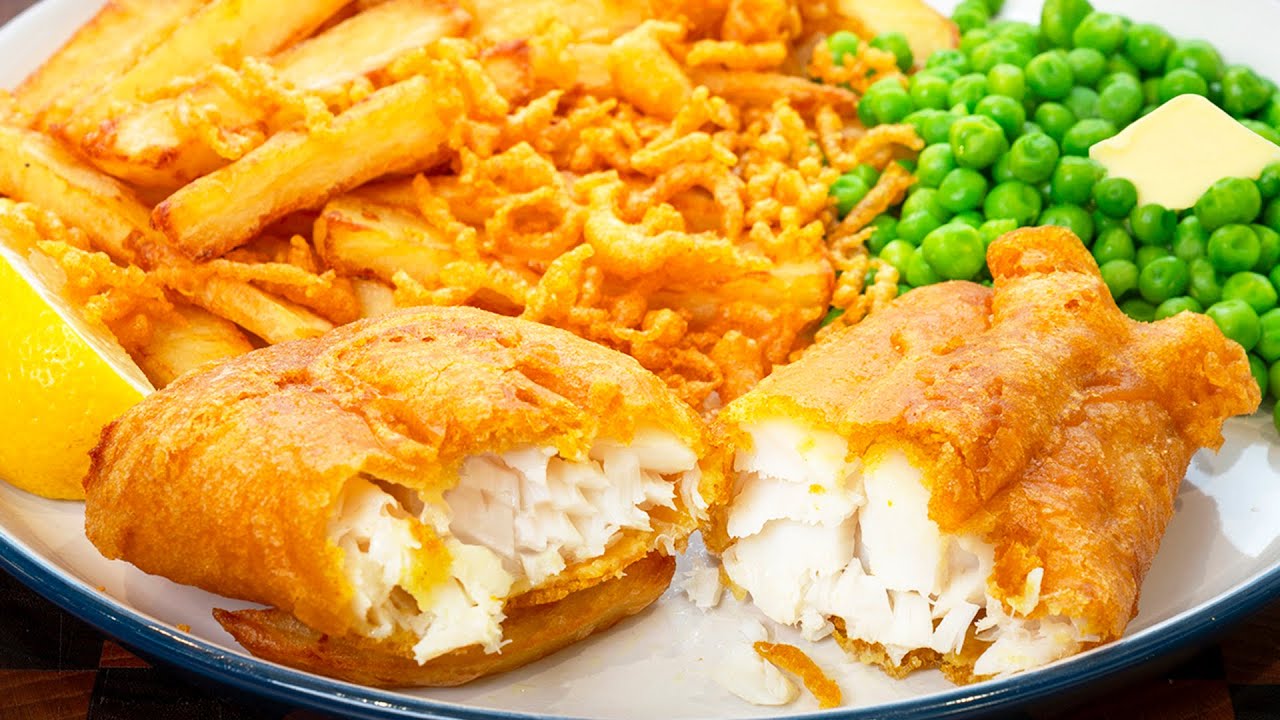The Ultimate Guide To Traditional Fish And Chips In Batter - History, Recipe, And Tips
This hearty meal, consisting of crispy battered fish and golden fries, is beloved in the UK and worldwide. This comprehensive guide will delve into the history of fish and chips, provide a detailed traditional recipe, offer cooking tips, and answer common questions about this iconic dish.
Author:Callum FraserMay 20, 20243.3K Shares374.8K Views

Fish and chips in batter is a quintessential British dish that has delighted taste buds for generations. This hearty meal, consisting of crispy battered fish and golden fries, is beloved in the UK and worldwide. This comprehensive guide will delve into the history of fish and chips, provide a detailed traditional recipe, offer cooking tips, and answer common questions about this iconic dish. Whether you're a seasoned cook or a curious foodie, this guide will help you master the art of making perfect fish and chips in batter.
A Brief History Of Fish And Chips
Origins Of Fish And Chips
The origins of fish and chips can be traced back to the 19th century in England. The combination of fried fish and potatoes was a fusion of two culinary traditions:
- Fried Fish: Brought to England by Jewish immigrants from Portugal and Spain in the 17th century. They introduced the practice of frying fish in oil.
- Chips: The practice of frying potatoes is believed to have originated in either France or Belgium.
The Rise Of Fish And Chips Shops
The first fish and chips shops, known as "chippies," began appearing in the mid-1800s. Joseph Malin, a Jewish immigrant, is credited with opening the first recorded fish and chips shop in London in 1860. By the early 20th century, fish and chips had become a staple of the British diet, with thousands of chippies across the country.
Cultural Significance
Fish and chips became an affordable and filling meal for the working class, particularly during the Industrial Revolution. Its popularity surged during both World Wars when it was one of the few foods not rationed. Today, fish and chips remain a cherished part of British culture and cuisine.
Traditional Fish And Chips Recipe
Ingredients
For The Batter:
- 1 cup all-purpose flour
- 1 teaspoon baking powder
- 1 teaspoon salt
- 1 cup cold beer or sparkling water
- Optional: a pinch of turmeric for color
For The Fish:
- 4 pieces of white fish fillets (such as cod, haddock, or pollock)
- Salt and pepper to taste
- Additional flour for dredging
For The Chips:
- 4 large russet potatoes
- Salt to taste
- Vegetable oil for frying
Equipment Needed
- Deep fryer or a large heavy-bottomed pot
- Thermometer
- Paper towels
- Mixing bowls
- Whisk
- Tongs
Preparation Steps
Preparing The Chips
- Peel and Cut: Peel the potatoes and cut them into thick strips (about 1/2 inch thick).
- Soak: Soak the potato strips in cold water for at least 30 minutes to remove excess starch.
- Dry: Drain and pat the potatoes dry with paper towels.
Pre-frying The Chips
- Heat Oil: Heat oil in a deep fryer or pot to 300°F (150°C).
- First Fry: Fry the potatoes in batches for about 4-5 minutes until they are soft but not browned. Remove and drain on paper towels.
Preparing The Fish
- Season: Season the fish fillets with salt and pepper.
- Dredge: Dredge the fillets in flour, shaking off the excess.
Making The Batter
- Mix Dry Ingredients: In a mixing bowl, whisk together the flour, baking powder, and salt.
- Add Liquid: Gradually whisk in the beer or sparkling water until the batter is smooth and free of lumps. The batter should be thick enough to coat the back of a spoon.
Frying The Fish
- Heat Oil: Increase the oil temperature to 350°F (180°C).
- Coat and Fry: Dip each fillet into the batter, allowing the excess to drip off. Carefully lower the fillets into the hot oil and fry until golden brown and crispy, about 5-7 minutes. Fry in batches to avoid overcrowding.
- Drain: Remove the fillets with tongs and drain on paper towels.
Final Fry For The Chips
- Increase Oil Temperature: Increase the oil temperature to 375°F (190°C).
- Second Fry: Return the pre-fried chips to the hot oil and fry until golden brown and crispy, about 2-3 minutes.
- Drain and Season: Remove the chips with a slotted spoon, drain on paper towels, and season with salt.
Serving
Serve the fish and chips immediately, hot and crispy. Traditionally, fish and chips are accompanied by malt vinegar, tartar sauce, and mushy peas.
Tips For Perfect Fish And Chips
Choosing The Right Fish
- Freshness: Use the freshest fish possible for the best flavor and texture.
- Type: White fish fillets such as cod, haddock, or pollock work best. They have a mild flavor and firm texture that holds up well to frying.
Perfecting The Batter
- Cold Ingredients: Ensure the beer or sparkling water is cold to create a light, crispy batter.
- Consistency: The batter should be thick enough to coat the fish evenly but not too thick that it becomes heavy.
- Resting: Let the batter rest for about 10 minutes after mixing to allow the baking powder to activate fully.
Frying Tips
- Oil Temperature: Use a thermometer to monitor the oil temperature accurately. Frying at the correct temperature ensures a crispy exterior and tender interior.
- Avoid Overcrowding: Fry in small batches to maintain the oil temperature and prevent the food from becoming greasy.
- Double Frying: Pre-frying the chips at a lower temperature and then finishing at a higher temperature results in the perfect texture – fluffy on the inside and crispy on the outside.
Additional Techniques
- Blanching: For even crispier chips, blanch the potato strips in boiling water for 2-3 minutes before frying.
- Seasoning: Season the fish and chips immediately after frying while they are still hot to help the salt adhere better.
Variations And Accompaniments
Batter Variations
- Beer Batter: Adds a rich flavor and light texture.
- Tempura Batter: A lighter, crispier option using cold sparkling water and rice flour.
- Herbed Batter: Add chopped fresh herbs such as parsley or dill for added flavor.
Chip Variations
- Sweet Potato Chips: Substitute regular potatoes with sweet potatoes for a different flavor and texture.
- Wedges: Cut the potatoes into wedges for a chunkier, heartier chip.
Traditional Accompaniments
- Malt Vinegar: The classic choice for drizzling over fish and chips.
- Tartar Sauce: A creamy, tangy sauce made with mayonnaise, pickles, and capers.
- Mushy Peas: A traditional British side dish made by mashing boiled peas with butter and mint.
FAQs About Traditional Fish And Chips In Batter
What Is The Best Oil For Frying Fish And Chips?
The best oil for frying fish and chips is one with a high smoke point, such as vegetable oil, canola oil, or peanut oil. These oils can withstand high temperatures without burning, ensuring a crispy finish.
Can I Make Fish And Chips Without A Deep Fryer?
Yes, you can make fish and chips without a deep fryer by using a large, heavy-bottomed pot for frying. Ensure the pot is deep enough to hold enough oil to fully submerge the fish and chips.
How Do I Store And Reheat Leftover Fish And Chips?
Store leftover fish and chips in an airtight container in the refrigerator for up to 2 days. Reheat in a preheated oven at 375°F (190°C) for about 10-15 minutes, or until heated through and crispy.
Can I Use Frozen Fish Fillets For Fish And Chips?
Yes, you can use frozen fish fillets for fish and chips. Thaw the fillets completely and pat them dry with paper towels before seasoning and battering.
How Can I Make Gluten-free Fish And Chips?
To make gluten-free fish and chips, use a gluten-free flour blend and gluten-free beer or sparkling water for the batter. Ensure all other ingredients and surfaces are free from gluten contamination.
Conclusion
Mastering traditional fish and chips in batteris a rewarding culinary experience that brings a taste of British heritage to your kitchen. By following this comprehensive guide, you'll learn how to prepare perfectly crispy fish and golden chips, along with tips and variations to customize the dish to your liking. Whether you're cooking for family, friends, or yourself, fish and chips is a delicious and satisfying meal that never fails to impress.

Callum Fraser
Author
Callum Fraser isn't just a writer about Scotland; he's a product of its rugged landscape and rich history. Born and raised in Perthshire, with the Highlands as his backyard, his love for the nation's stories was kindled by local storytellers and long walks through ancient glens.
This passion led him to pursue a degree in Scottish History from the University of Edinburgh. For over 15 years, Callum has dedicated himself to exploring and documenting his homeland, fusing his academic knowledge with essential, on-the-ground experience gained from charting road trips through the Cairngorms, hiking the misty Cuillins of Skye, and uncovering the secrets of traditional recipes in his family's kitchen.
As the Editor-in-Chief and Lead Author for Scotland's Enchanting Kingdom, Callum's mission is simple: to be your most trusted guide. He combines meticulous research with a storyteller's heart to help you discover the authentic magic of Scotland — from its best-kept travel secrets to its most cherished traditional recipes.
Latest Articles
Popular Articles